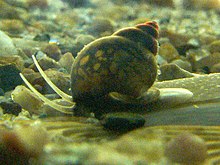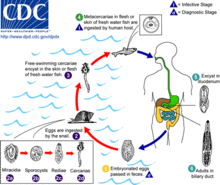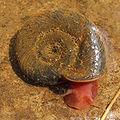Freshwater snail


Freshwater snails are
According to a 2008 review of the taxonomy, there are about 4,000 species of freshwater gastropods (3,795–3,972).[1]
As of 2023 there are known 5182 species of fossil freshwater gastropods.[2]
At least 33–38 independent lineages of gastropods have successfully colonized freshwater environments.[3] It is not possible to quantify the exact number of these lineages yet, because they have yet to be clarified within the Cerithioidea.[3] From six to eight of these independent lineages occur in North America.[4]
Taxonomy
2005 taxonomy
The following
| |||||||||||||||||||||||||||||||||||||||||||||||||||||||||||||||||||||||||||||||||||||||||||||||||
2010 taxonomy
The following
| |||||||||||||||||||||||||||||||||||||||||||||||||||||||||||||||||||||||||||||||||||||||||||
Neritimorpha
The
- Neritiliidae - 5 extant freshwater species[1]
- Neritidae - largely confined to the tropics, also the rivers of Europe, family includes the marine "nerites".[7] There are about 110 extant freshwater species.[1]
-
Family Neritidae, shells of Theodoxus fluviatilis.
-
FamilyNeritina natalensis
Caenogastropoda
The Caenogastropoda are a large group of gilled operculate snails, which are largely marine. In freshwater habitats there are ten major families of caenogastropods, as well as several other families of lesser importance:
- Architaenioglossa
- Ampullariidae - an exclusively freshwater family that is largely tropical and includes the large "apple snails" kept in aquaria.[7] About 105–170 species.[1]
- Viviparidae - medium to large snails, live-bearing, commonly referred to as "mystery snails". Worldwide except South America, and everywhere confined to fresh waters.[7] About 125–150 species.[1]
-
Family Ampullariidae, Pomacea bridgesii.
-
Family Viviparidae, Viviparus viviparus.
- Sorbeoconcha
- Melanopsidae - family native to rivers draining to the Mediterranean, also Middle East, and some South Pacific islands.[7] About 25–50 species.[1]
- Pachychilidae - 165–225 species.[1] native to South and Central America. Formerly included with the Pleuroceridae by many authors.
- Paludomidae - about 100 species in south Asia, diverse in African Lakes, and Sri Lanka.[1] Formerly classified with the Pleuroceridae by some authors.
- Pleuroceridae - abundant and diverse in eastern North America, largely high-spired snails of small to large size.[7] About 150 species.[3]
- Semisulcospiridae - primarily eastern Asia, Japan, also the Juga snails of northwestern North America. Formerly included with the Pleuroceridae. About 50 species.[3]
- Thiaridae - high-spired parthenogenic snails of the tropics, includes those referred to as "trumpet snails" in aquaria.[7] About 110 species.[3]
-
Family Melanopsidae, Melanopsis praemorsa
-
FamilyIo fluvialis.
-
Family Semisulcospiridae, Semisulcospira kurodai.
-
FamilyMelanoides tuberculata.
- Littorinimorpha
- Littorinidae - 9 species in the genus Cremnoconchus are freshwater living in streams and waterfalls.[8] Other species are marine.
- Amnicolidae - about 200 species.[1]
- Assimineidae - about 20 freshwater species,[1] other are marine
- Bithyniidae - small snails, native to Eastern Hemisphere.[7] About 130 species.[1]
- Cochliopidae - about 246 species.[1]
- Helicostoa sinensis lives in China.[1]
- Hydrobiidae - small to very small snails found worldwide.[7] About 1250 freshwater species[1] other are marine.
- Lithoglyphidae - about 100 species.[1]
- Moitessieriidae - about 55 species.[1]
- Pomatiopsidae - small amphibious snails scattered worldwide, most diverse in eastern and Southeast Asia.[7] About 170 species.[1]
- Stenothyridae - about 60 freshwater species,[1] others are marine.
-
Family Bithyniidae, Bithynia tentaculata.
-
FamilyAntrobia culveri.
-
FamilyHelicostoa sinensisshells.
-
Family Hydrobiidae, Sadleriana fluminensis
-
Family Lithoglyphidae, Lithoglyphus naticoides.
-
Family Pomatiopsidae, Oncomelania hupensis.

- Neogastropoda
- Nassariidae - 8–10 freshwater species in the genus Anentome and Clea,[1] native to Southeast Asia. Other Nassariidae are marine.
- Marginellidae - 2 freshwater species in the genus Rivomarginella,[1] native to Southeast Asia. Other Marginellidae are marine.
Heterobranchia


- Lower Heterobranchia
- Glacidorbidae - 20 species.[1]
- Valvatidae - small low-spired snails referred to as "valve snails". 71 species.[1]
- Acochlidiidae (including synonym Strubelliidae) - 5 shell-less species:[1] Acochlidium amboinense, Acochlidium bayerfehlmanni, Acochlidium fijiiensis, Palliohedyle sutteri and Strubellia paradoxa[9]
- Tantulidae - there is only one species[1] which is shell-less Tantulum elegans.
- Pulmonata, Basommatophora
Basommatophorans are pulmonate or air-breathing aquatic snails, characterized by having their eyes located at the base of their tentacles, rather than at the tips, as in the true land snails Stylommatophora. The majority of basommatophorans have shells that are thin, translucent, and relatively colorless, and all five freshwater basommatophoran families lack an operculum.
- or three species.
- Acroloxidae - about 40 species.[1]
- Lymnaeidae - found worldwide, but are most numerous in temperate and northern regions.[7] These are the dextral (right-handed) pond snails. About 100 species.
- Planorbidae - "rams horn" snails, with a worldwide distribution.[7] About 250 species.[1]
- Physidae - left-handed (sinistral) "pouch snails", native to Europe, Asia, North America.[7] About 80 species.[1]
-
Family Acroloxidae, Acroloxus lacustris.
-
Family Lymnaeidae, Lymnaea stagnalis.
-
Family Physidae, Physella acuta.
-
Family Planorbidae, Planorbarius corneus.
Sexual reproduction and self-fertilization
The freshwater snail Physa acuta is in the subclass Heterobranchia and the family Physidae. P. acuta is a self-fertile snail that can undergo either sexual reproduction or self-fertilization. Noel et al.[10] experimentally tested whether accumulation of deleterious mutations is avoided either by inbreeding populations of the snail (undergoing self-fertilization), or in outbreeding populations undergoing sexual reproduction. Inbreeding promotes the homozygous expression of deleterious recessive mutations in progeny that then exposes these mutations to selective elimination because of their deleterious affects on progeny. Outbreeding sexual reproduction allows females to choose male mating partners with smaller mutation loads that then also leads to a reduction of deleterious mutations in progeny. On the basis of their findings, Noel et al.[10] concluded that both outbred and inbred populations of P. acuta can efficiently eliminate deleterious mutations.
As human food
Several different freshwater snail species are eaten in Asian cuisine.
Archaeological investigations in Guatemala have revealed that the diet of the Maya of the Classic Period (AD 250–900) included freshwater snails.[11]
-
A Bengali dish of stir-fried freshwater snails with onion and garlic paste and other spices, from Kolkata, West Bengal, India
Aquarium snails
Freshwater snails are commonly found in aquaria along with tropical fish. Species available vary in different parts of the world. In the United States, commonly available species include
Parasitology

Freshwater snails are widely known to be hosts in the lifecycles of a variety of human and animal
See also
- Terrestrial molluscs
- Land snail
- Land slug
- Sea snail
- Sea slug
References
This article incorporates CC-BY-2.5 text from the reference[14]
- ^ .
- ISSN 1464-7931.
- ^ .
- ISBN 978-1-58112-930-4.
- ^ ISSN 0076-2997.
- .
- ^ a b c d e f g h i j k l m n Banarescu P. (1990). Zoogeography of Fresh Waters, Vol. 1, General Distribution and Dispersal of Freshwater Animals. AULA - Verlag, Weisbaden.
- .
- .
- ^ a b Noël E, Fruitet E, Lelaurin D, Bonel N, Ségard A, Sarda V, Jarne P, David P. Sexual selection and inbreeding: Two efficient ways to limit the accumulation of deleterious mutations. Evol Lett. 2018 Dec 10;3(1):80-92. doi: 10.1002/evl3.93. PMID 30788144; PMCID: PMC6369961
- ^ Foias A. E. (2000). "Entre la política y economía: Resultados preliminares de las primeras temporadas del Proyecto Arqueológico Motul de San José" (PDF). XIII Simposio de Investigaciones Arqueológicas en Guatemala, 1999 (Edited by J.P. Laporte, H. Escobedo, B. Arroyo and A.C. De Suasnávar) (in Spanish): 771–799. Archived from the original (PDF online publication) on 2009-03-18. Retrieved 2009-03-01., page 777.
- ^ John Wiley and Sons, New York. 822 pp.
- ISBN 0-387-30068-6. page 178.
- ^ .
Further reading
- J. Mouthon, Typology of molluscs of flowing water; biotypological organisations; socioecological groupings; Annls Limnol. Volume 17, Number 2, 1981
- Haynes A. (2000). "The distribution of freshwater gastropods on four Vanuatu islands: Espiritu Santo, Pentecost, Éfate and Tanna (South Pacific)". doi:10.1051/limn/2000006, PDF.
- Vermeij J. & Wesselingh F. P. (2002). "Neogastropod molluscs from the Miocene of western Amazonia, with comments on marine to freshwater transitions in molluscs". .
- J.B. Burch, Freshwater snails of North America; 1982 - nepis.epa.gov.



















